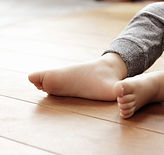
Children's Feet
Children`s Feet
Children with strong, healthy feet often avoid many kinds of lower extremity problems later in life. The foot is the foundation of mobility, so it' s important to get any potential problems evaluated and remedied as soon as possible.
Infants
The size and shape of your baby's feet change quickly during their first year. Because a baby's feet are flexible, too much pressure or strain can affect their feet's shape. It's important to allow your baby to kick and stretch his or her feet. Also, make sure shoes and socks do not squeeze the toes.
Toddlers
Try not to force your toddler to walk before she is ready. Carefully watch his/her gait once she begins to walk. If your toddler's toe touches down instead of the heel, or she always sits while others play, contact our office for an exam. Many toddlers have a pigeon-toe gait, and this is normal. Most children outgrow the problem, however we have physical therapy and corrective devices available should the problem persist.
When foot care is needed
To help with flatfeet, special shoes or custom-made shoe inserts may be prescribed. To correct mild intoeing, your toddler may need to sit in a different position while playing or watching TV. If you child's feet turn in or out a lot, corrective shoes, splints, or night braces may be prescribed.
The foot's bone structure is well-formed by the time your child reaches age 7 or 8, but if a growth plate (the area where bone growth begins) is injured, the damaged plate may cause the bone to grow oddly. With a doctor's care, however, the risk of future bone problems is reduced.
Remember to check your child's shoe size often. Make sure there is space between the toes and the end of the shoe and that their shoes are roomy enough to allow the toes to move freely. Don't let your child wear hand-me-downs or they may inherit the uneven wearing of the previous owner which can condition an unnatural walking gait.
.png)
.png)






